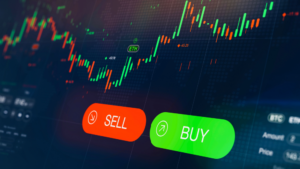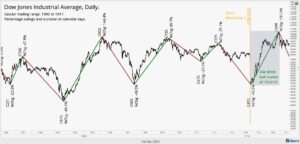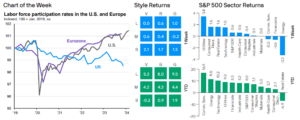Friday, 26th November, 2021
1/ Historic monthly moves since 1928
2/ The months with the best track record
3/ The First Day in December is a Good Day to Be a Buyer
4/ The bottom line
1/ Historic Monthly Moves Since 1928
Today as the U.S. stock markets moved through the sleepy, low-volume trading session on an abbreviated schedule, investors and professional fund managers are likely plotting their strategy for the end of the year and the beginning of 2022. At least that’s what the historical data from the S&P 500 Index (SPX) would seem to suggest. Data shows that December is historically a month when people tend to buy stocks.
Most people who have been around the markets have heard the time-worn phrase, “sell in May and go away.” The phrase, “when shopping to stuff your Christmas socks, don’t forget to buy your investment stocks,” has never materialized in culture, but perhaps it should have. Comparing the performance of a hypothetical purchase of SPX at the beginning of December looks surprisingly favorable.
While it is certainly true that an investor could not have purchased the index for most of this stretch, it is no longer functionally impossible to do so. Since 1992, investors have increasingly felt the need to buy exchange-traded funds (ETFs) that closely track the S&P 500. Funds such as State Street’s S&P 500 Index ETF (SPY) or Vanguard’s S&P 500 Index ETF (VOO) are popular, heavily-traded instruments. So today more than ever, it is appropriate to consider whether the timing for purchasing an S&P 500 index fund can make a difference in returns.
Such an effort runs the risk of mistaking correlation for causation, of course, because merely looking at the data alone can’t give a reason for why performance variation occurs. However, the fact that any performance variation occurs at all is worth noting since investors might be able to deduce their own reasons for it and take advantage of it all the same.
For this study, a chart watcher can use a simple methodology to compare the performance of trading at the start of a given month. Assuming that a trade entry was made at the closing price of the first day of each month, and the then closed out 20 trading days later, we can then compare and determine which month shows the best performance. As a benchmark, we can compare against the average return for a 20-session trade on SPX. As the chart below shows, the average return for a 20-session trade of all days since 1928 is a positive .44% (shown by the blue bar).


2/ The Months With the Best Track Record
The first trading day of both December and April have an average 20-session return that tops the first day of all other months. Both show a positive 1.22% return that implies a surprisingly distinct advantage for buyers on those days compare to the average of all other days.
The data also happens to give credence to the idea that May is not a good time to be a buyer, but surprisingly a much worse time appears to be buying on the first day of September. Perhaps it isn’t too surprising that the first trading day of April and January are shown to be strong performers. These represent the beginning of the first and second quarters, respectively, and so it is reasonable to assume that investment professionals are actively allocating money to positions around these times. That’s a simple hypothesis for the outperformance.
But it seems less intuitive to expect that December would also show such strong performance. December’s strong performance isn’t just about quality either, it’s also about the frequency with which it turns in positive performances.


3/ The First Day in December is a Good Day to Be a Buyer
Buying on the close of the first available trading day of December and holding for 20 trading sessions (just under one month of calendar time) has turned in positive returns over 71% of the time since 1928 when the S&P 500 index was first established. While chart watchers would likely assume that SPX had more positive periods than negative ones, they may be unaware that it is so much higher than a coin toss. A robust 60% of the more than 23,000 trading days tracked in the history of the index are shown to close higher than they did 20-sessions before.
If you single out the first trading day in December for all those years, you observe a startling 71% of them close higher. This win rate is the highest of all the months, leaving the first trading day in December as the best performer among all 12 such days in the year. The reason for this likely have to do with investment manager behaviors. Perhaps portfolio managers had a propensity for closing out profitable positions for the year and reinvesting the profits to establish new positions before the new year changes, but there is little likelihood of being able to confirm that notion.
4/ The Bottom Line
Establishing a position in S&P 500 stocks on the first trading day of December might be worth considering. This day shows a better track record of both performance and frequency of positive returns than any other similar days in the year.
—
Originally posted on 26th November, 2021
Disclosure: Investopedia
Investopedia.com: The comments, opinions and analyses expressed herein are for informational purposes only and should not be considered individual investment advice or recommendations to invest in any security or to adopt any investment strategy. While we believe the information provided herein is reliable, we do not warrant its accuracy or completeness. The views and strategies described on our content may not be suitable for all investors. Because market and economic conditions are subject to rapid change, all comments, opinions and analyses contained within our content are rendered as of the date of the posting and may change without notice. The material is not intended as a complete analysis of every material fact regarding any country, region, market, industry, investment or strategy. This information is intended for US residents only.
Disclosure: Interactive Brokers
Information posted on IBKR Campus that is provided by third-parties does NOT constitute a recommendation that you should contract for the services of that third party. Third-party participants who contribute to IBKR Campus are independent of Interactive Brokers and Interactive Brokers does not make any representations or warranties concerning the services offered, their past or future performance, or the accuracy of the information provided by the third party. Past performance is no guarantee of future results.
This material is from Investopedia and is being posted with its permission. The views expressed in this material are solely those of the author and/or Investopedia and Interactive Brokers is not endorsing or recommending any investment or trading discussed in the material. This material is not and should not be construed as an offer to buy or sell any security. It should not be construed as research or investment advice or a recommendation to buy, sell or hold any security or commodity. This material does not and is not intended to take into account the particular financial conditions, investment objectives or requirements of individual customers. Before acting on this material, you should consider whether it is suitable for your particular circumstances and, as necessary, seek professional advice.






























